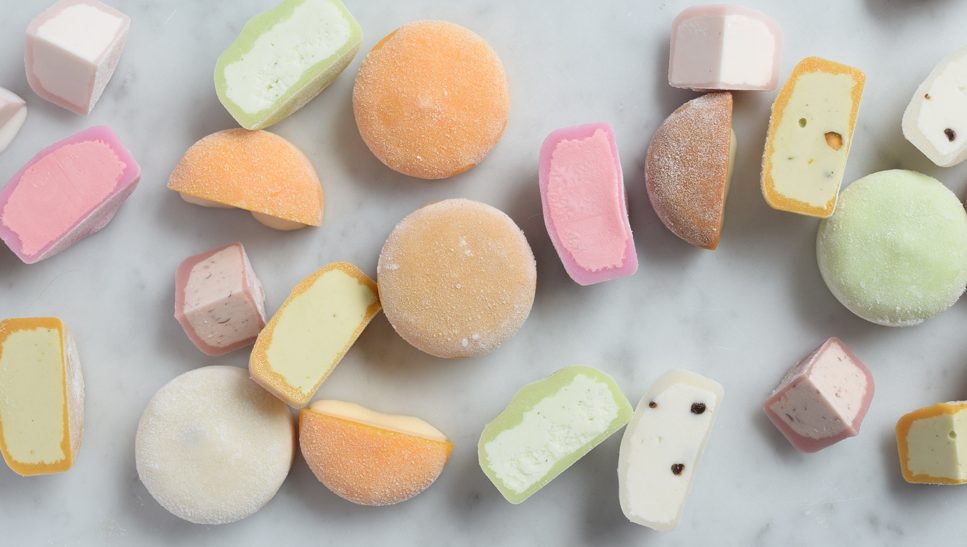Mochi are a Japanese delicacy. Traditionally eaten as part of New Year festivities, they are soft and gooey rice cakes made from an especially glutinous variety of short grain rice. After being steamed and pounded with giant wooden hammers, the rice transforms into a pliable, sticky dough that is shaped into balls and eaten – or wrapped around yummy fillings, sealed tight and enjoyed as a treat.
Kagami Mochi – a New Year’s Tradition
Mochi are enjoyed throughout the year, but they are the centerpiece of kagami mochi – or mirror mochi – a traditional New Year’s decoration found in homes throughout Japan. Kagami mochi are believed to house inadama – the soul or spirit that dwells within rice, a crop that has been essential to Japanese culture for centuries. Kagami mochi are offerings to Toshigami, a Shinto deity who visits homes on New Year’s day and bestows blessings for a good harvest and a long life.

In design, kagami mochi are like a snowman. A big rice cake forms the base, a medium-sized rice cake sits in the middle, and a daidai – a small citrus fruit and a symbol of longevity – goes on top. During the holidays, these edible pyramids are displayed in special alcoves or on a kamidana – a household altar. To mark the end of the holiday season, families eat their kagami mochi in a celebratory mochi-breaking ceremony.
Mochitsuki: The Pounding of Rice
Traditional mochi making is an annual year-end tradition, a team effort – and a bit risky! Friends and families gather for mochi making parties, and temples and community centers host daylong events. First, mochigome rice is soaked overnight and then steamed; the rice is ready to be pounded when it’s soft enough to be cut with a chopstick. Then, the rice is placed into a usu – a big wooden or stone bowl – and massaged into a single ball. This is where the danger comes in: To turn the rice into a mound of stretchy, sticky and uniform dough, one person repeatedly swings a kine – a heavy wooden mallet the size of a sledgehammer – into the mass of rice, while another person flings water on it to keep it from sticking and reaches into the usu to flip the dough over and slap it down. The two must work in perfect synchronization to avoid injury. This fast-paced dance continues until each individual grain of rice has disappeared and a giant ball of mochi has taken its place.
How to Make Mochi at Home
There is a family-friendly way to make mochi that won’t result in injury – and doesn’t require overnight soaking or cumbersome sledgehammers. We asked Natsume Aoi, Culinary Director of Mochidoki, a company that specializes in gourmet mochi, for an easy recipe to make at home.
Ingredients
12 – 14 servings
• 1 cup mochiko (sweet rice flour)
• 1 ½ cups water
• ⅓ cup sugar
• ¾ tsp salt
• ~1 cup filling of your choice, roughly 1 tbsp of filling per ball. Common fillings are red bean paste, white bean paste, whole dried apricots, candied chestnuts or ice cream.
Directions
• Whisk ingredients together in a heatproof glass bowl until all mochiko has dissolved.
• Place the bowl into a steamer basket and steam for 12 to 15 minutes. At the halfway point, stir mochi to even out the texture.
• You’ll know the mochi is done when it becomes a translucent white – and has a soft, sticky texture.
• Cover your workstation with a liberal dusting of cornstarch or katakuriko (potato starch).
• Working quickly, roll out a roughly ¼-inch-thick sheet of mochi onto the prepared surface.
• Cut the mochi into rounds using a cookie cutter.
• Brush off any excess cornstarch or potato starch.
• Place prepared filling in the center of each disc and carefully wrap the dough around it, creating completely sealed balls.
• Store the mochi in an airtight container at room temperature. They’ll keep for up to three days.
• If using ice cream as a filling, prepare scoops of ice cream ahead of time and freeze the finished mochi balls. When you’re ready to serve, allow the mochi to sit at room temperature for a few minutes before eating.
Aoi’s advice is to work fast. “Mochi dough is very sticky when it comes out of the steamer, but this is when it’s easiest to shape or roll. If the dough cools down too much, it will be much more difficult to manage.” Another pro tip? Avoid fillings that have too much moisture – otherwise liquid may seep out from the seams.

Most importantly, have fun! Experiment with different flavor and texture combinations. Aoi likes to serve mochi in the style of an ice cream sundae, with a topping of slivered almonds, strawberries and dark chocolate sauce. Or, kick it old-school and enjoy the handheld snack all on its own.




